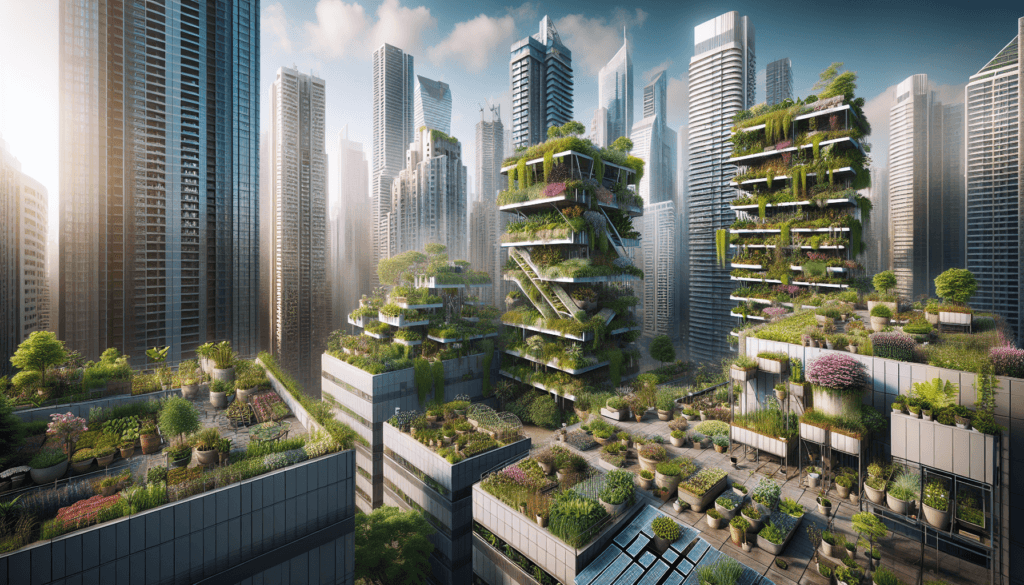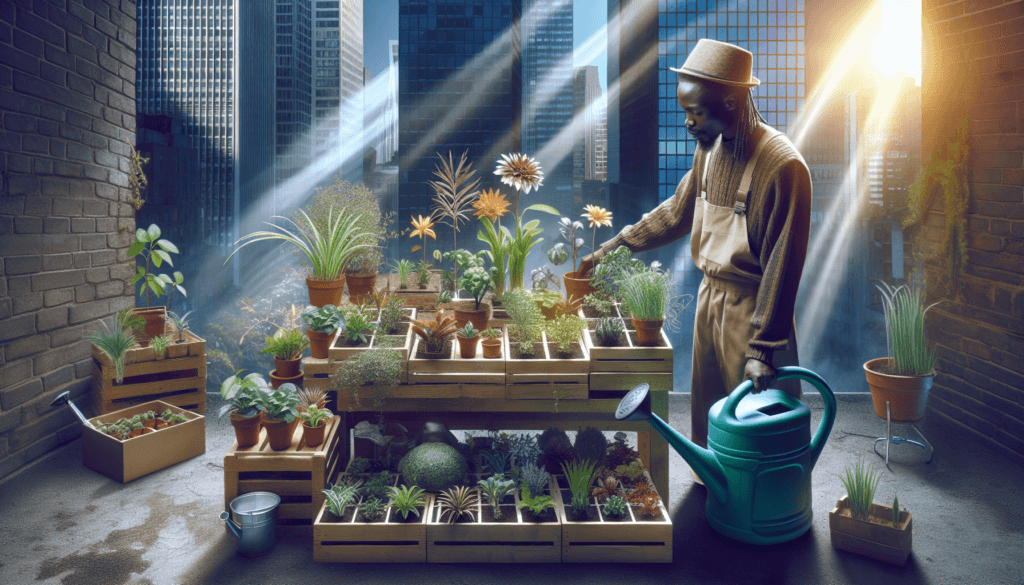Interested in starting your own urban garden? Look no further! This article will provide you with valuable tips on how to choose the perfect plants for your space. Whether you have a small balcony or a tiny backyard, we have got you covered. From understanding the amount of sunlight your space receives to selecting plants that thrive in urban environments, we will help you create a stunning and thriving garden that suits your unique urban oasis. So, let’s dive into the world of urban gardening and discover the ideal plants for your space!

Evaluate Your Space
Consider the Size of Your Space
When choosing plants for your urban garden, it’s essential to consider the size of your space. Evaluate whether you have a small balcony, a rooftop, or a backyard. The available space will determine the types and number of plants you can accommodate. If you have limited space, you might opt for smaller plants or vertical gardening techniques to maximize your growing area. On the other hand, if you have a larger space, you can incorporate a variety of plants and even create distinct sections for different plant species.
Assess the Lighting Conditions
Light plays a crucial role in the growth and development of plants. Take some time to assess the lighting conditions in your chosen gardening area. Is it exposed to direct sunlight throughout the day, partially shaded, or mostly in shade? Different plants have varying light requirements, so it’s important to choose plants that match the lighting conditions of your space. If you have limited sunlight, consider shade-loving plants or explore options like grow lights for indoor gardening.
Determine the Temperature Range
The temperature range in your gardening area is another crucial factor to consider when selecting suitable plants. Some plants thrive in warmer climates, while others prefer cooler temperatures. Take note of the average temperatures in your region and choose plants that are well-suited for those conditions. If you live in an area with extreme temperature fluctuations, you might need to consider additional measures such as providing shade or insulation for your plants to ensure their survival.
Understand Your Time Commitment
Consider Your Availability
Maintaining a garden requires regular care and attention. Before choosing plants, consider your availability and how much time you can dedicate to gardening. Some plants require daily watering, while others may only need watering once a week. Additionally, plants may require pruning, fertilizing, and pest control measures at different intervals. If you have a busy schedule or often travel, it’s essential to choose plants that can thrive with minimal maintenance or consider utilizing automated irrigation systems.
Determine Your Level of Engagement
Beyond availability, it’s important to assess your level of engagement with gardening. Are you a beginner looking for low-maintenance plants, or do you enjoy getting your hands dirty and engaging in more hands-on gardening activities? Understanding your level of engagement will help you select plants that align with your gardening preferences. Some plants require more specialized care and attention, such as pruning, staking, or training, which can be satisfying for those who enjoy being actively involved in their garden.
Choose Suitable Plant Types
Consider the Space Constraints
Whether you have limited space or ample room, it’s important to consider the space constraints when choosing plants. If you have a small balcony or limited floor space, opt for plants that don’t spread too much or have compact growth habits. Compact varieties or plants that can be trained or pruned to maintain their size are ideal choices. On the other hand, if space is not an issue, you can explore larger plant options that can create a more lush and vibrant garden.
Select Plants of Different Heights and Sizes
To create visual interest and ensure efficient use of space, consider selecting plants of different heights and sizes. By incorporating plants with varying heights, you can add depth and dimension to your garden. Taller plants can serve as a backdrop for smaller ones, creating an aesthetically pleasing arrangement. Additionally, by selecting plants with different growth habits, such as prostrate varieties or climbers, you can make the most of vertical space and maximize your garden’s potential.
Choose Plants with Similar Watering Needs
Watering is a crucial aspect of plant care, and it’s important to choose plants with similar watering needs to simplify your gardening routine. Plants that have similar water requirements will thrive when watered together, making it easier to establish a consistent watering schedule. This is especially important if you plan on utilizing automated irrigation systems or if you have multiple plants that will share the same watering space. Grouping plants with similar watering needs also helps prevent overwatering or underwatering, ensuring their overall health and vitality.
Consider Indoor or Outdoor Gardening
Decide Between Indoor or Outdoor Gardening
One of the first decisions you’ll need to make is whether you’ll be practicing indoor or outdoor gardening. Indoor gardening allows you to grow plants within the confines of your home, while outdoor gardening utilizes an external space, such as a balcony, patio, or backyard. Consider the advantages and limitations of each option. Indoor gardening provides better control over lighting and climate but may have space constraints and require additional provisions for adequate sunlight. Outdoor gardening allows for natural sunlight and a wider range of plant choices but may be subject to weather conditions and pest pressure.
Adapt to Your Climate
Another important aspect to consider when deciding between indoor or outdoor gardening is your climate. Different plants thrive in different climates, so it’s crucial to select plants that can adapt to your local climate conditions. If you live in a region with harsh winters or extreme temperatures, you might prefer indoor gardening or choose plants that can tolerate those conditions. Conversely, if you have a mild climate or longer growing seasons, you have more flexibility in your plant selection. Understand your climate and choose plants that have a higher chance of success in your specific area.

Determine the Purpose of Your Garden
Consider Your Personal Preferences
Your personal preferences play a significant role in determining the purpose and layout of your garden. Take some time to think about the ambiance and style you want to create. Do you prefer a tranquil garden oasis with lush foliage and calming colors, or a vibrant, colorful garden that catches the eye? Understanding your personal preferences will help you select plants that align with your desired garden style and create a space where you feel most comfortable and at peace.
Decide on the Function of Your Garden
Beyond personal preferences, consider the function of your garden. Do you want it to be a space for relaxation and leisure, a source of fresh herbs and vegetables, or a habitat for beneficial pollinators and local wildlife? Understanding the purpose of your garden will help you choose plants accordingly. If you’re aiming for a tranquil space, incorporating plants with soothing fragrances and soft textures can enhance the ambiance. For a vegetable garden, focus on selecting plants that are edible and productive. To attract pollinators, choose flowering plants that provide nectar and pollen for bees, butterflies, and hummingbirds.
Research Plant Hardiness Zones
Identify Your Zone
Understanding your plant hardiness zone is crucial for selecting plants that can thrive in your specific location. Plant hardiness zones are standardized regions that indicate the average minimum winter temperatures in different areas. By identifying your zone, you can choose plants that are known to be hardy and able to withstand the winter temperatures in your region. This helps ensure the survival and long-term health of your plants, minimizing the risk of cold damage.
Choose Plants Suitable for Your Zone
Once you have identified your zone, research and choose plants that are suitable for that specific zone. Nurseries and garden centers often label their plants with suitable zones, so finding plants that can handle the conditions in your area becomes easier. Selecting plants suited to your zone increases the likelihood of success and reduces the chances of plants succumbing to extreme weather conditions. However, if you’re willing to put in additional effort, you can also experiment with plants from neighboring zones and provide extra protection during extreme weather events.

Consider Seasonal Variations
Plan for Seasonal Changes
When planning your garden, it’s important to account for seasonal changes and the different conditions each season brings. Consider how your garden will evolve throughout the year and plan accordingly. In spring, you might focus on early-flowering bulbs and seedlings, while summer may require heat-tolerant plants. Fall might call for plants with vibrant foliage or late-season blooming varieties, and winter can be an opportunity for evergreens or cold-tolerant plants. By incorporating plants with a variety of seasonal interests, you can enjoy a visually appealing garden that changes throughout the year.
Choose Plants with Different Blooming Periods
To ensure a continuous display of color and blooms in your garden, choose plants with different blooming periods. Some plants bloom in spring, others in summer, and some even continue flowering into fall. By selecting a mix of early, mid, and late-season bloomers, you can enjoy a floral spectacle that extends throughout the growing season. This not only adds visual interest but also provides nectar sources for pollinators throughout the year, supporting their populations and promoting a healthy ecosystem in your garden.
Learn About Plant Requirements
Research Watering and Fertilizing Needs
Understanding the watering and fertilizing needs of your chosen plants is vital for their overall health. Some plants prefer consistently moist soil, while others thrive in drier conditions. Research the specific watering requirements of each plant and create a watering schedule that meets their needs. Similarly, fertilizing requirements may vary depending on the plant species, so familiarize yourself with their preferences. Over-watering or over-fertilizing can lead to root rot or nutrient imbalances, while under-watering or under-fertilizing can stunt growth and reduce plant vigor.
Consider Soil and Drainage Requirements
Soil type and drainage are crucial factors that impact plant growth. Some plants thrive in well-draining soil, while others prefer moisture-retentive soil. Assess your soil type and make amendments as necessary to create an optimal growing environment. If you have heavy clay soil, you may need to incorporate organic matter to improve drainage. Conversely, if you have sandy soil, you might need to boost its water-holding capacity. It’s essential to choose plants that are compatible with your soil type and provide proper drainage to prevent issues like root rot and waterlogging.

Select Plants Compatible with Your Lifestyle
Consider Maintenance and Care
When choosing plants, it’s important to consider your lifestyle and the amount of time and effort you can dedicate to maintenance and care. If you have a busy schedule or limited time for gardening tasks, opt for low-maintenance plants that require less pruning, watering, and other routine care. Succulents, for example, are known for their drought tolerance and can thrive with minimal attention. On the other hand, if you enjoy spending time in your garden and have the capacity to commit to regular maintenance, you can choose more demanding plants that may require pruning, training, or specific care routines.
Choose Plants that Align with Your Style and Taste
The plants you choose should not only be functional and easy to care for but should also align with your style and taste. Consider the aesthetic you want to achieve and select plants that complement your overall vision. Do you prefer a modern and minimalist style or a lush and tropical paradise? Take inspiration from design trends or create a style that reflects your personality. By selecting plants that resonate with your style and taste, your urban garden becomes an extension of your personal expression and brings you joy every time you step into it.
Seek Expert Advice
Consult Local Garden Centers
If you’re feeling overwhelmed or unsure about selecting the right plants for your urban garden, don’t hesitate to seek advice from local garden centers. The knowledgeable staff at these establishments can guide you in choosing plants that thrive in your specific area. They can recommend plant varieties that are known to be successful and offer guidance on planting practices, care, and maintenance. Take advantage of their expertise and ask questions to ensure you make informed choices for your urban garden.
Join Online Gardening Communities
In today’s digital age, connecting with fellow gardeners has never been easier. Joining online gardening communities allows you to expand your knowledge and seek advice from experienced gardeners around the world. These communities often have forums, social media groups, or dedicated platforms where you can discuss gardening topics, share experiences, and learn from others. Engaging in online communities can provide valuable insights, tips, and recommendations for selecting the right plants for your urban garden. It’s a great way to connect with like-minded individuals who share your passion for gardening.
In conclusion, choosing the right plants for your urban garden involves evaluating your space, understanding your time commitment, considering plant types, deciding between indoor or outdoor gardening, determining the purpose of your garden, researching plant hardiness zones, considering seasonal variations, learning about plant requirements, selecting plants compatible with your lifestyle, and seeking expert advice. By following these guidelines and taking into account your specific circumstances and preferences, you can create a thriving and beautiful urban garden that brings joy and fulfillment. Happy gardening!


